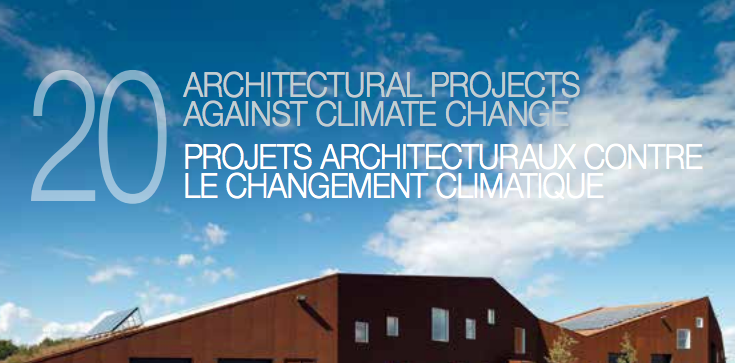20 Architectuurprojecten tegen klimaatverandering

Met steun van het programma Creative Europe van de EU ontwikkelde de ACE een tentoonstelling met 20 architectuurprojecten die bijdragen tot de vermindering van klimaatverandering en de aanpassing van onze samenleving aan de effecten ervan. De tentoonstelling wordt van 30 september tot 4 oktober in het Europees Parlement voorgesteld voorafgegaan door een beleidsseminarie omtrent Kwalitatieve Architectuurdiensten voor een Duurzame Omgeving.
Bewust van de klimaatverandering engageer de Architects’ Council of Europe zich tot het promoten van oplossingen die architecten kunnen brengen en de meerwaarde van goede architectuur. In het kader van haar Architects Against Climate Change campagne heeft de ACE, naar aanleiding van de COP21, een ‘Manifesto for Responsible Architecture’ onderschreven.
De brochure met de projecten door Baumschlager Eberle Architekten, Philippe Samyn and Partners architects & engineers, Projektil architekti, Christensen & co. Architects, Maison Edouard François, Epicuria Architectes, ARGE Bogevischs Buero Architekten & Stadtplaner, SHAG Schindler Hable Architekten, Reichel Schlaier Architekten, Habil István Kistelegdi, Dún Laoghaire Rathdown County Council Architects Department, Mirko Franzoso, 5.iela, M3 Architectes, Architecture Project, De Urbanisten, Municipality of Lisbon, Stefan Nesic, Grüntuch Ernst Architects, Marge Architects en Feilden Clegg Bradley Studios is hier beschikbaar.
Fully aware of the challenges posed by climate change, the Architects’ Council of Europe is committed to promote the solutions that architects can bring and the added-value of good Architecture. In the framework of its Architects Against Climate Change campaign, to mark the occasion of COP21, ACE endorsed a Manifesto for Responsible Architecture which promoted a set of principles to mitigate climate change and adapt our societies to the new climatic conditions, namely:
• Put people at the centre of urban development: a sustainable city is above all friendly and supportive. Its primary purpose is to create communal living conditions and facilitate social inclusion for present and future generations. A sustainable city is not one of closed groups and confinement but a lively city where public spaces belong to citizens.
• Promote the compact city and consider territories around cities: addressing challenges posed by climate change requires rethinking the prevailing model based on urban sprawl. Urban sprawl, in addition to increasing costs to the community, eats away natural areas at the expense of biodiversity. This scenario is incompatible with the development of a low-carbon city, which combines density and intensity in a balanced way. Access and mobility are its defining elements. A public transport service tailored to the needs of all citizens is a major priority. Territories should benefit from the energy and resources that surround them. Analysis of inflows and outflows beyond the city scale is crucial.
• Favour social and functional mix: the balanced planning of housing, offices, shops and community facilities is essential. The separation of urban functions through zoning should be rejected in favour of an integrated, mixed use approach to the city. A functional mix, based on short production circuits, land-take and soil sealing, is the key to better optimise resources and flows.
• Favour urban regeneration and adaptive re-use of our heritage: above all, the low-carbon city should be a reversible city that can rebuild itself from within. The extensive renovation of the existing building stock should be at the heart of public policy. Whilst respecting heritage conservation, let’s favour urban renewal and, whenever possible, avoid the development ex nihilo of new towns. Through smart restoration, renovation or transformation, our heritage and sites can find new, mixed or extended uses. As a result, their social and economic value increases, while their cultural significance is respected.
• Establish governance mechanisms shared by all: sustainable urban development requires collaborative planning that involves all urban developers: public authorities, residents, architects and the entire built environment team. Their action should be based on governance mechanisms shared by all.
• Favour innovative proposals: a project designed around communal architecture should aim for a more rational use of resources. During the design of new buildings or renovation operations, let’s encourage innovative solutions that favour shared spaces and facilities that can adapt to multiple uses.
• Give value to design studies: the environmental performance potential of a building is governed by solutions developed by the architect during the design stage. The building orientation and connection to its site, its compactness as well as its form, materials and long term flexibility are just as important as the thermal performance of materials and systems.
• Favour the use of local resources and solutions: use local resources adapted to context, delivered through short supply chains, to reduce the building’s carbon footprint and promote the “ownership” of the project by residents. Priority should be given to the environment by focusing on locally proven technical solutions.
• Study the life cycle and anticipate the building demolition and deconstruction: a greater emphasis is needed on the evaluation of buildings over their life cycle so that more architectural solutions are recognised as preferential over solutions that may appear more effective and lower cost in the short term. Responsible construction also considers waste and anticipates building demolition and deconstruction.
